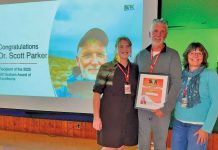
Nature Conservancy of Canada Asks Motorists To Help Turtles Cross The Road
News Release
May 24, 2023 (Tobermory/Bruce Peninsula, ON) — The Nature Conservancy of Canada (NCC) is reminding motorists to watch out for turtles crossing roads, as they seek mates and nesting grounds.
NCC is asking drivers to give turtles a “brake” by turning a keen eye to these threatened creatures.
Spring and summer are active periods for turtles as they emerge from their winter nesting areas to seek mates and new nesting sites. Like other reptiles, turtles are cold-blooded, and will often bask on gravel, sandy roadsides and warm asphalt. And while a turtle’s shell can protect it from predators, it is no match for a motor vehicle. Every turtle lost in a vehicle collision has a significant domino effect for the entire species.
Turtles count on the survival of the adults, especially females, to maintain population health. Females can take up to 25 years before reproducing, and their egg survival rate is very low; approximately only two eggs out of 100 become adult turtles. This means that a loss of one adult female turtle is the loss of 20 or more years of development. Studies show that just a five per cent increase in annual mortality can put an entire population at risk of decline.
All eight of Ontario’s turtle species are at risk. The two biggest threats are habitat loss and road mortality from collisions with vehicles. NCC encourages motorists to slow down when they see a turtle on the road, and to check to be sure they can safely steer around it.
Wildlife crossing signs have been installed along multiple roads on the Bruce Peninsula where high levels of turtle activity have been observed. This includes signs recently installed along Cape Hurd Road near Tobermory. Motorists are encouraged to be extra vigilant when passing through these signed areas, especially between May and September when turtles are most active.
“Turtles are biodiversity heroes and play an important role in keeping wetlands clean by removing harmful bacteria and cycling nutrients, helping wetland ecosystems thrive and remain healthy. Road mortality is a major threat to turtles, so we hope that these signs will encourage drivers to slow down and brake for turtles.”
– Jacob Kloeze, Coordinator, Conservation Biology – Saugeen Bruce Peninsula, Nature Conservancy of Canada.
Tips and facts:
• To help a turtle safely cross the road, first make sure road conditions are safe for you to pull over. Put your safety first.
• Always move the turtle in the same direction it was going, otherwise it may try to cross again.
• For turtles that hide their heads in their shells (like Midland painted turtle), simply pick the turtle up, gently holding it with both hands, supporting its belly and holding the top of its shell, the way you might hold a hamburger, and carry it across the road. Carry it close to the ground — you don’t want to drop it.
• Snapping turtles can weigh as much as 34 kilograms and have heavy, spiked tails and massive, armoured shells. These turtles cannot hide their heads in their shells and have a dangerously sharp snout. They are large and grey. To move them and avoid injury to the turtle, lift them using the “handles” on either side of their tails on the back of their shells and “wheelbarrow” them across the road on their front legs. If you have a car mat or a shovel, carefully slide the turtle onto this and drag the matt or shovel across the road.
• Once you have moved the turtle, back away and let it be, to avoid causing it additional stress.
• Never push or shove turtles across the road with your feet or a stick. Their shells are not as thick underneath, and rough pavement can do a lot of damage.
• Other threats to turtles include poaching, illegal collection for the pet trade and invasive species. For example, phragmites, or common reed, is an invasive wetland grass that grows aggressively and impedes turtle habitat by restricting the species’ movement and shading out basking locations.
About
The Nature Conservancy of Canada (NCC) is the country’s unifying force for nature. NCC seeks solutions to the twin crises of rapid biodiversity loss and climate change through large-scale, permanent land conservation. As a trusted partner, NCC works with people, communities, businesses and government to protect and care for our country’s most important natural areas.
Since 1962, NCC has brought people together to conserve and restore more than 15 million hectares. To learn more, visit natureconservancy.ca.














